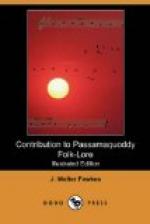[Footnote 27: By combining this story with some given by Leland it would seem that the child was Glooscap. If that is so, this is the only account in Passamaquoddy lore in which his parthenogenetic origin is traced. Mrs. Brown insists, however, that the medicine man was not Glooscap.]
At last she decided to make a canoe of bark, and in it she put her child and let it float down the river. The water of the river was rough, but the child was not harmed, or even wet.[28] It floated down to an Indian village, and was stranded on the shore near a group of wigwams. A woman of the village found the baby on the shore and brought it to her home. Every morning, after the baby had been brought to the place, a baby of the village died. The Indians did not know what the matter was until they noticed that the waif which the woman had found in the bark on the river bank went to the river every night and returned shortly after. A woman watched to see what this had to do with the death of the babes, and she saw the child, when it returned to the wigwam, bring a tongue of a little child, roast and eat it. Then it laid down to sleep. The next morning another child died, and then the Indian knew that its tongue had been cut out. It was therefore believed that the strange child had killed the baby. They deliberated as to what they should do with the murderer. Some said, cut him in pieces and cast the fragments into the river. Others said, cut him up and burn the fragments. This, after much consultation, they did. They burnt the fragments of the child until nothing but the ashes remained. Everybody thought it dead, but the next morning it came back to camp again, with a little tongue as before, roasted and ate the morsel. The next morning another child was found to have died the night before. After the weird child had roasted and eaten the tongue of its victim he laid down to sleep in the same place he had laid before he had been cut up into fragments and cremated. But in the morning the child said that it would never kill any more children. He had now, in fact, become a big boy. He said he would take one of his bones out of his side. This he tried to do, and as he did it all the bones came out of his body at the same time. Then he closed his eyes by drawing his fingers over his eyelids so that his eyes were hidden (not necessarily blind). He could not move, because he had no bones and had grown very fat. He became a great medicine man, and told the Indians that whatever they asked of him he would grant them. Then the Indians moved away from the place and left the medicine man behind in a nice wigwam which they built for him. But they were accustomed to go back when they wished anything, and to ask the conjurer for it. The Indians used to go to him for medicine of all kinds. When he granted their request he said, “Turn me over and you will find the medicine under me."[29]
[Footnote 28: The resemblance of this story to the tale of Moses is very great. Whether or not it is derived from the early teaching of the church through Catholic priests, or from still earlier Norse legends, I leave others to decide.]




